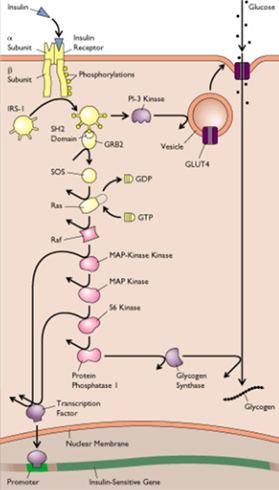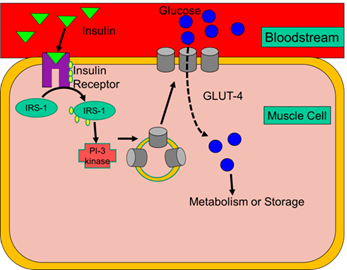Type II Diabetes
Physical activity can reduce someone's risk for developing type II diabetes. Aerobic exercise increases sensitivity to insulin, lowers blood pressure, improves cholesterol and decreases body fat. Physical activity and exercise play a particularly important role in type II diabetes and can even reverse the disease in special cases of extreme lifestyle adjustments.
Type II Diabetes
Type II diabetes is caused by insulin resistance as a result of both genetic disposition and environmental factors such as a sedentary lifestyle and poor diet. In non-diabetics, transport of glucose into cells requires special transport proteins, GLUT-4s. When GLUT-4's are not being used, they are stored in the intracellular membrane. Once activated, they travel to the cell membrane and become functional when insulin combines with insulin receptors or when muscle cells exercise. In type II diabetics, insulin resistance rises with obesity and lack of exercise causing a lack of GLUT-4's (glucose transporters) in the membrane of muscle cells.
Exercise increases the expression of GLUT-4's, which help rid the body of excess glucose by converting it into glycogen. The images below show the difference between facilitated glucose transport in a non-diabetic and facilitated glucose transport in a diabetic.

Glucose transport in type II diabetes

Normal glucose transport
Insert video on exercise and GLUT-4 signaling : http://sph.bu.edu/otlt/lamorte/psa/diabetes
GLUT signaling pathway images are from class slides
In the meta-analysis Role of Physical Activity in Diabetes Management and Prevention by Charlotte Hayes and Dr. Andrea Kiska ( http://www.sciencedirect.com/science/article/pii/S0002822308000175) state that with the growing prevalence of obesity and type 2 diabetes, inactivity is becoming an urgent public health concern. The authors note that after review of 4 trials, three of which were randomized control trials a 31% to 63% decrease in progression of type II diabetes was exhibited in pre-diabetics. Below is an excerpt from their paper summarizing their observations.
"Physical activity is recognized to produce multiple general and diabetes-specific health benefits. Yet despite the multitude of benefits, many people are physically inactive. As the prevalence of overweight and obesity, pre-diabetes, and type 2 diabetes has continued to rise at an alarming rate, physical inactivity has become an urgent public health concern ... In addition to impacting development of type 2 diabetes, regular physical activity participation is associated with numerous health benefits for the individual with diabetes. Physical activity appears to have an independent, beneficial effect on insulin action, glycemic control, and metabolic abnormalities associated with type 2 diabetes."
Put in Red box:
Exercise improves diabetes by:
- Improving glucose control ( A1C)
- Reducing triglyceride-rich VLDL
- Lowering of blood pressure
- Increasing sensitivity to insulin in muscle cells
- Supporting weight loss and muscle building
Rejeski, JW, Ip EH, Bertoni AG, Bray G,Evans G, Gregg EW, Zhang Q, Lifestyle Change and Mobility in Obese Adults with Type 2 Diabetes. New England journal of Medicine 366;13 nejm.org march 29, 2012 (insert hyperlink https://learn.bu.edu/courses/1/13fallsphph709_a1/groups/_25650_1//_1747170_1/Weight%20Loss%20and%20Exercise%20for%20type%202%20diabetes.pdf )
The purpose of this randomized control trial conducted in 2011 was to assess if loss of mobility in type II diabetics was slowed after an intensive lifestyle intervention. The study followed 5,016 obese, type II diabetic individuals (45-75 years of age) for four years. Subjects were randomly assigned to either an intensive lifestyle intervention cohort or a diabetes support-and education program cohort. The intervention group was instructed to make dietary changes and increase physical activity level to 180 minutes a week. Compared to the diabetes support and education cohort the intervention group had a relative reduction in the severity of mobility related disability of 48%. The authors state that "this effect was mediated by both weight loss and improvement in fitness."
The overwhelming evidence of the benefits of physical activity for diabetics is not without its limitations. Behavior change is difficult and starting a regular exercise routine has many barriers. In the longitudinal cohort study Predictors of Sustained Walking among Diabetes Patients in Managed Care: The translating Research into Action for Diabetes (TRIAD) Study (insert hyperlink http://www.ncbi.nlm.nih.gov/pmc/articles/PMC2517953) the authors observed 5,935 patients with diabetes who walked for at least 20 minutes a day at baseline. The investigators found that patients suffering from obesity, pain and comorbidities had difficulty sustaining a walking routine. This is only one example of why it is important for public health research to continue to research interventions that address barriers to maintaining a physically active lifestyle.
Put in red box:
http://www.diabetes.org/food-and-fitness/fitness (Insert Link)
American Diabetes Association
The American Diabetes Association recommends both aerobic and strength exercises to improve the body's use of insulin.
Aerobic Exercise Recommendations:
A goal of 30 minutes of moderate-to-vigorous intensity aerobic exercise for at least 5 days a week is ideal. It is recommended to spread your activity levels throughout the week, try to not go 2 days in row without exercising. Some types of aerobic activities include:
- Brisk walking (outside or inside on a treadmill)
- Bicycling/Stationary cycling indoors
- Dancing
- Low-impact aerobics
- Swimming or water aerobics
- Playing tennis
- Stair climbing
- Jogging/Running
- Hiking
- Rowing
- Ice-skating or roller-skating
- Cross-country skiing
- Moderate-to-heavy gardening
Strength Training Recommendations:
It is recommended doing some type of strength training 2-3 days each week in addition to aerobic activity in order to make your body more sensitive to insulin and help lower blood glucose.
- Some types of strength training activities include:
- Weight machines or free weights at the gym
- Using resistance bands
- Lifting light weights or objects like canned goods or water bottles at home
- Calisthenics or exercises that use your own body weight to work your muscles (examples are push ups, sit ups, squats, lunges, wall-sits, and planks)
- Classes that involve strength training
- Other activities that build and keep muscle like heavy gardening
Additional works cited:
- Eriksson K.F., Lindgarde F. . Prevention of type 2 (non-insulin dependent) diabetes mellitus by diet and physical exercise. Diabetologia, 34 (1991), pp. 891-898
- Wadden TA, West DS, Delahanty L, et al. The Look AHEAD study: a description of the lifestyle intervention and the evi- dence supporting it. Obesity (Silver Spring) 2006;14:737-52.
- Hayes C, Kriska A. Role of physical activity in diabetes management and prevention. Journal of the American Diabetic Association.Volume 108, Issue 4, Supplement, April 2008, Pages S19-S23
- Eriksson K.F, Lindgarde F. Prevention of type 2 (non-insulin dependent) diabetes mellitus by diet and physical exercise. Diabetologia, 34 (1991), pp. 891-898
- X. Pan, G. Li, Y. Hu, J. Wang, W. Yang, Z. An, Z. Hu, J. Lin, J. Xiao, H. Cao, P. Liu, X. Jiang, Y. Jiang, J. Wang, H. Zheng, H. Zhang, P. Bennett, B. Howard. Effects of diet and exercise in preventing NIDDM in people with impaired glucose tolerance: The Da Qing IGT and diabetes study. Diabetes Care, 20 (1997), pp. 537-544
